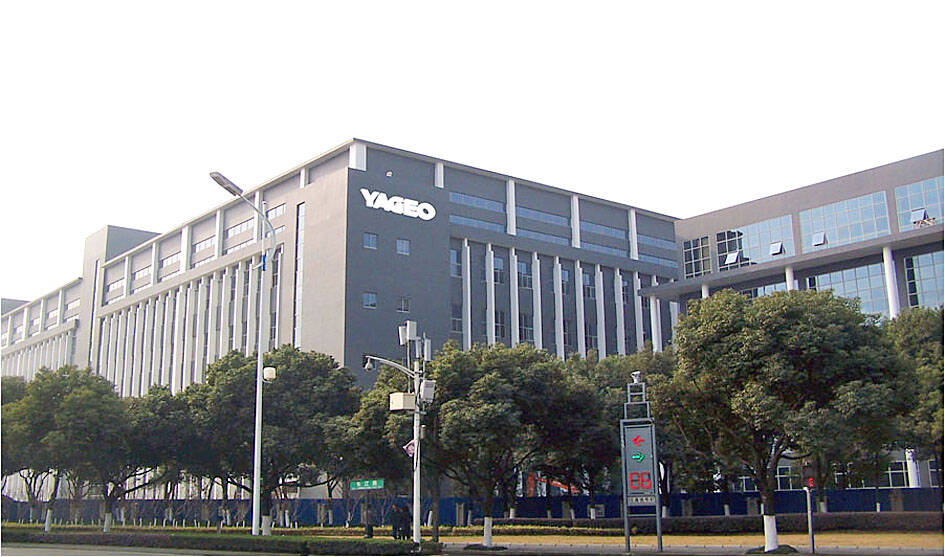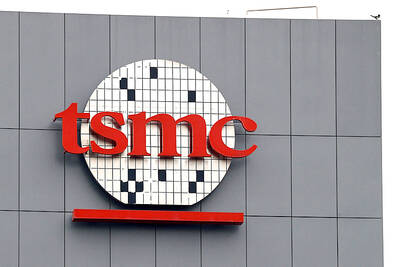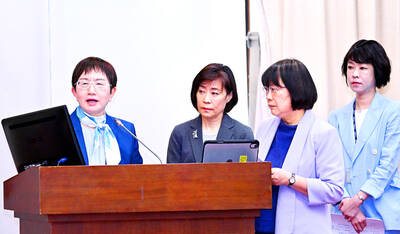Yaego Corp (國巨), the world’s No. 3 multilayer ceramic capacitor (MLCC) supplier, yesterday reported its weakest quarterly net profit in about four years, affected by sagging customer demand due to inventory correction and seasonal weakness.
Net profit last quarter sank 22.83 percent year-on-year to NT$3.65 billion (US$111.21 million) compared with NT$4.73 billion in the same period last year, hitting the lowest level since the third quarter of 2020.
On a sequential basis, net profit plummeted 35.4 percent from NT$5.65 billion in the third quarter last year.

Photo: Chang Hui-wen, Taipei Times
Earnings per share dropped to NT$7.1 from NT$9.43 a year earlier and NT$11.01 a quarter earlier.
Last year as a whole, Yageo still grew its net profit by about 11 percent to NT$19.36 billion from NT$17.43 billion in 2023. EPS rose to NT$38.18 from NT$37.74 in the prior year.
“This is probably the first time in the MLCC market’s history that we had back-to-back declining years. This is not something we or the industry was expecting,” Yageo executive vice president of global sales and marketing Claudio Lollini told a virtual investors’ conference.
However, the MLCC industry is “showing signs of improvement,” Lollini said. “And we can see that in our own book-to-bill [ratio]... Most of our products have positive book-to-bill [ratios], so we think the MLCC cycle is, hopefully, no longer on decline. I think we are beyond that. We’ll see some growth, but perhaps not very strong growth.”
Visibility on inventory levels from direct automotive and industrial customers is likely to remain low through this summer, he said.
Revenue this quarter would be little changed from the NT$30 billion made in the fourth quarter, the company said.
“Because of the Lunar New Year holiday, the first quarter is usually a low season, but we should be able to maintain the revenue [momentum] this time. Revenue would be flattish,” Yageo chief executive officer David Wang (王淡如) said.
“Our book-to-bill ratio now is higher than one. So, this is very, very positive,” Wang said. “Our distribution and channel inventory level is also very, very healthy, which is also very encouraging.”
Gross margin is expected to improve between 1.5 and 3 percentage points this quarter, from 33.2 percent last quarter, Wang said.
He attributed the improvement to increasing demand for artificial intelligence-related applications, computers, servers and consumer electronics from Asia, China, in particular.
Factory utilization is expected to drop to 70 percent for premium products and to 60 percent for standard products, from 75 percent and 65 percent last quarter, due to the long holiday, Wang said.
Factory utilization would improve quarter by quarter this year, he added.
Yageo said the US’ plan to hike tariffs is really a challenging issue as it is still evolving.
“However, largely speaking, I think we have good exposure in China, Mexico and Europe. And I think there is a decent split of our operations across different areas. So we’ll try to leverage that existence and try to make the best use of it,” Yageo chief financial officer Eddie Chen (陳彥松) said.
Yageo is not in a rush to adjust its global capacity before it gets a clear picture of the market situation, Chen said.

SECTOR LEADER: TSMC can increase capacity by as much as 20 percent or more in the advanced node part of the foundry market by 2030, an analyst said Taiwan Semiconductor Manufacturing Co (TSMC, 台積電) is expected to lead its peers in the advanced 2-nanometer process technology, despite competition from Samsung Electronics Co and Intel Corp, TrendForce Corp analyst Joanne Chiao (喬安) said. TSMC’s sophisticated products and its large production scale are expected to allow the company to continue dominating the global 2-nanometer process market this year, Chiao said. The world’s largest contract chipmaker is scheduled to begin mass production of chips made on the 2-nanometer process in its Hsinchu fab in the second half of this year. It would also hold a ceremony on Monday next week to

TECH CLUSTER: The US company’s new office is in the Shalun Smart Green Energy Science City, a new AI industry base and cybersecurity hub in southern Taiwan US chip designer Advanced Micro Devices Inc (AMD) yesterday launched an office in Tainan’s Gueiren District (歸仁), marking a significant milestone in the development of southern Taiwan’s artificial intelligence (AI) industry, the Tainan City Government said in a statement. AMD Taiwan general manager Vincent Chern (陳民皓) presided over the opening ceremony for the company’s new office at the Shalun Smart Green Energy Science City (沙崙智慧綠能科學城), a new AI industry base and cybersecurity hub in southern Taiwan. Facilities in the new office include an information processing center, and a research and development (R&D) center, the Tainan Economic Development Bureau said. The Ministry

ADVERSARIES: The new list includes 11 entities in China and one in Taiwan, which is a local branch of Chinese cloud computing firm Inspur Group The US added dozens of entities to a trade blacklist on Tuesday, the US Department of Commerce said, in part to disrupt Beijing’s artificial intelligence (AI) and advanced computing capabilities. The action affects 80 entities from countries including China, the United Arab Emirates and Iran, with the commerce department citing their “activities contrary to US national security and foreign policy.” Those added to the “entity list” are restricted from obtaining US items and technologies without government authorization. “We will not allow adversaries to exploit American technology to bolster their own militaries and threaten American lives,” US Secretary of Commerce Howard Lutnick said. The entities

Minister of Finance Chuang Tsui-yun (莊翠雲) yesterday told lawmakers that she “would not speculate,” but a “response plan” has been prepared in case Taiwan is targeted by US President Donald Trump’s reciprocal tariffs, which are to be announced on Wednesday next week. The Trump administration, including US Secretary of the Treasury Scott Bessent, has said that much of the proposed reciprocal tariffs would focus on the 15 countries that have the highest trade surpluses with the US. Bessent has referred to those countries as the “dirty 15,” but has not named them. Last year, Taiwan’s US$73.9 billion trade surplus with the US